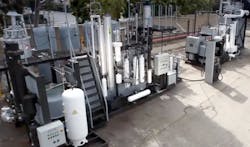Landfill waste to H2 and RNG Energy demonstration underway at SoCalGas’ LA facility
Kore Infrastructure is testing and demonstrating a carbon-negative waste-to-energy modular system at the utility Southern California Gas Co.’s Los Angeles facility.
The system diverts organic waste from landfills in California and convert this waste into carbon-negative hydrogen and renewable natural gas (RNG).
At the facility, Kore Infrastructure intends to demonstrate the production of 99.999% pure hydrogen by the third quarter of 2022 that will be suitable for fuel cell electric cars, trains, buses and trucks. The facility will have the capacity to process 24 tons of organic feedstock per day and produce one metric ton of carbon negative, UltraGreen hydrogen per day.
The UltraGreen hydrogen thus produced will be enough to power more than 1,400 fuel cell electric cars. The facility began processing feedstocks last year.
Kore Infrastructure modular system for waste-to-energy conversion uses a proprietary pyrolysis process for the conversion. The process uses high temperatures to heat organic waste in a no-oxygen environment and convert it to a blend of gases, which can then, be converted to carbon-negative hydrogen or RNG, and solid carbon char, which is useful in enhancing soil quality or decarbonizing cement and steel production.
The process is designed to meet the South Coast AQMD's ultra-low NOx and particulate emissions standards. Landfill
"This is the type of novel approach that we need to see more of that uses sustainable processes," said Ben J. Benoit, Chair of the South Coast AQMD Governing Board. "Not only will it divert material from landfills, but the process will create clean energy sources that can be used in fuel cell vehicles and other clean-air technologies."
Organic matter which decomposes at landfills produces large amounts of methane, which is a chemical compound of one carbon atom bonded to four hydrogen items. Left to emit from landfills, methane is considered to have over 30 times more global warming potential than carbon dioxide emitted into the atmosphere.
About the Author
EnergyTech Staff
Rod Walton is senior editor for EnergyTech.com. He has spent 17 years covering the energy industry as a newspaper and trade journalist.
Walton formerly was energy writer and business editor at the Tulsa World. Later, he spent six years covering the electricity power sector for Pennwell and Clarion Events. He joined Endeavor and EnergyTech in November 2021.
He can be reached at [email protected].
EnergyTech is focused on the mission critical and large-scale energy users and their sustainability and resiliency goals. These include the commercial and industrial sectors, as well as the military, universities, data centers and microgrids.
Many large-scale energy users such as Fortune 500 companies, and mission-critical users such as military bases, universities, healthcare facilities, public safety and data centers, shifting their energy priorities to reach net-zero carbon goals within the coming decades. These include plans for renewable energy power purchase agreements, but also on-site resiliency projects such as microgrids, combined heat and power, rooftop solar, energy storage, digitalization and building efficiency upgrades.
